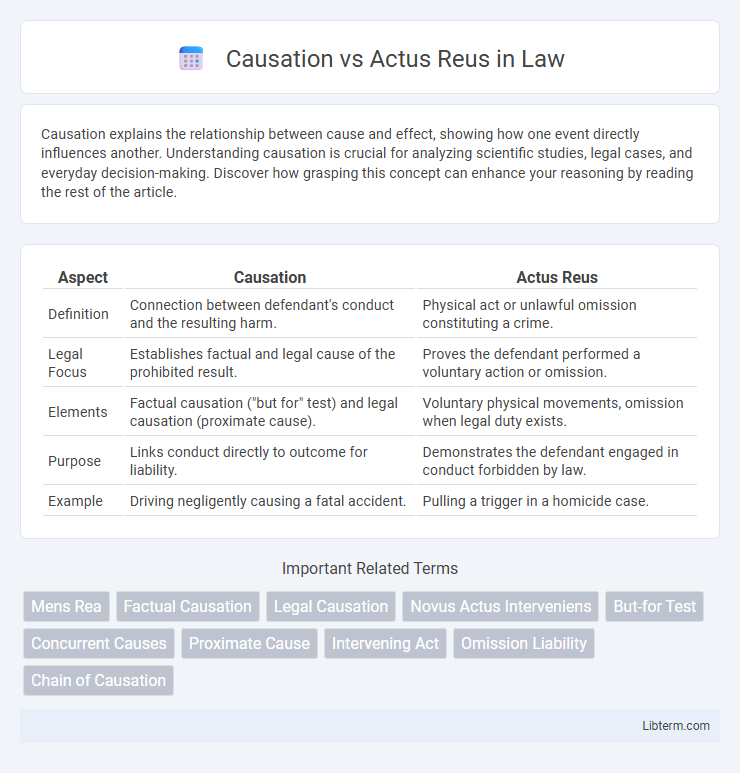Causation explains the relationship between cause and effect, showing how one event directly influences another. Understanding causation is crucial for analyzing scientific studies, legal cases, and everyday decision-making. Discover how grasping this concept can enhance your reasoning by reading the rest of the article.
Table of Comparison
| Aspect | Causation | Actus Reus |
|---|---|---|
| Definition | Connection between defendant's conduct and the resulting harm. | Physical act or unlawful omission constituting a crime. |
| Legal Focus | Establishes factual and legal cause of the prohibited result. | Proves the defendant performed a voluntary action or omission. |
| Elements | Factual causation ("but for" test) and legal causation (proximate cause). | Voluntary physical movements, omission when legal duty exists. |
| Purpose | Links conduct directly to outcome for liability. | Demonstrates the defendant engaged in conduct forbidden by law. |
| Example | Driving negligently causing a fatal accident. | Pulling a trigger in a homicide case. |
Understanding Causation in Criminal Law
Understanding causation in criminal law requires examining the direct link between the defendant's conduct and the resulting harm, establishing that the actus reus led to the prohibited consequence. The legal test for causation often involves both factual causation, determined by the "but for" test, and legal causation, assessing whether the result was a foreseeable outcome of the defendant's actions. Proving causation is essential to hold the defendant criminally liable, as it connects the wrongful act with the criminal result beyond mere coincidence.
Defining Actus Reus: The Physical Element
Actus reus refers to the physical element of a crime, encompassing the voluntary actions, omissions, or states that constitute the criminal conduct. It requires a demonstrable act or failure to act that breaches a legal duty, forming the tangible basis for criminal liability. Establishing actus reus is essential before causation is considered, as it proves the defendant's external conduct linked to the alleged offense.
The Role of Causation in Criminal Liability
Causation in criminal liability establishes a direct link between a defendant's conduct and the resulting harm, ensuring legal responsibility only when the actus reus (physical act) leads to the prohibited consequence. Courts apply the "but-for" test and proximate cause principles to determine if the defendant's actions are a substantial factor in bringing about the outcome. Accurate causation analysis prevents conviction for unintended consequences, maintaining fairness in attributing criminal liability.
Differentiating Between Causation and Actus Reus
Causation in criminal law refers to the requirement that the defendant's conduct must be the factual and legal cause of the prohibited harm, establishing a direct link between the act and the result. Actus reus encompasses the physical element of a crime, including a voluntary action, omission, or state of affairs that constitutes the breach of law. Differentiating between causation and actus reus is crucial because causation addresses the connection between conduct and outcome, while actus reus pertains to the conduct itself necessary to constitute a criminal offense.
Types of Causation: Factual vs Legal
Types of causation distinguish between factual and legal causation within actus reus, the physical element of a crime. Factual causation, determined by the "but for" test, requires that the harm would not have occurred but for the defendant's conduct, establishing a direct link. Legal causation, or proximate cause, imposes limits by considering whether the defendant's actions are sufficiently connected to the harm, excluding events too remote or unforeseeable.
Establishing Actus Reus: Key Considerations
Establishing actus reus requires proving a voluntary physical act or unlawful omission directly linked to the resulting harm, focusing on the defendant's conduct rather than mere causation. Key considerations include the element of voluntariness, ensuring the act was a conscious control of the body, and the clear manifestation of a prohibited act under the law. Causation remains relevant but secondary, serving to connect the actus reus to the harm rather than defining the actus reus itself.
Chain of Causation: Breaking the Link
The chain of causation in criminal law links the defendant's act (actus reus) to the resulting harm, establishing legal responsibility. Breaking the link occurs when an intervening act (novus actus interveniens) is sufficiently independent, unforeseeable, or abnormal to relieve the defendant of liability. Courts analyze whether the original act remains a significant cause of the consequence or if the new event supersedes it, effectively disrupting the chain of causation.
Common Legal Issues: Causation vs Actus Reus
Causation and actus reus are fundamental elements in criminal law that often cause confusion in legal proceedings. Actus reus refers to the physical act or unlawful omission that constitutes a criminal offense, while causation links that act to the resulting harm or consequence. Disputes frequently arise over whether the defendant's conduct directly caused the harm or if intervening factors broke the causal chain, impacting liability and conviction outcomes.
Case Law Illustrating Causation and Actus Reus
The distinction between causation and actus reus is critical in criminal law, with causation linking the defendant's actions to the resulting harm, while actus reus refers to the physical act itself. Case law such as R v White (1910) established that but-for causation must be proven, as the defendant's act must be a factual cause of the harm. In R v Pagett (1983), the court held that the defendant's act does not need to be the sole cause of harm but must be an operative and substantial cause, illustrating the nuance in establishing actus reus through causation.
Implications for Defendants: Legal Defenses and Challenges
Causation and actus reus are critical in establishing criminal liability, with causation linking the defendant's conduct to the harm and actus reus representing the physical act of the crime. Defendants face challenges in disproving causation, often relying on legal defenses such as intervening cause or lack of factual causation to break the chain of liability. Successfully contesting actus reus can result in acquittal by demonstrating absence of voluntary or unlawful action, significantly impacting the prosecution's burden of proof.
Causation Infographic

 libterm.com
libterm.com